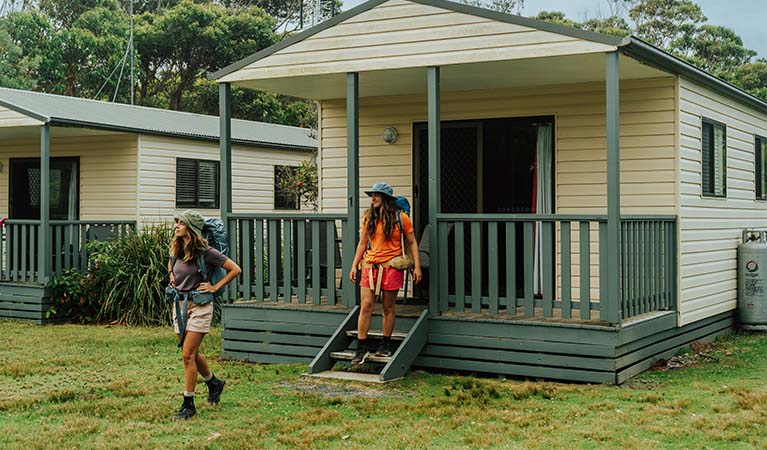Pretty Beach cabins
Murramarang National Park
Overview
Pretty Beach cabins are perfect for a family getaway. Enjoy breathtaking views complete with all modern amenities in the middle of Murramarang National Park.
| Accommodation type | Cabin |
|---|---|
| Where | 1 Pretty Beach Road, Pretty Beach, NSW, 2539 - in Murramarang National Park |
| Bedrooms | 2 |
| Maximum guests | 4 |
| Facilities | Drinking water, showers, toilets, electric power, kitchen, plates and cutlery, pots and pans, tv, rubbish bin |
| What to bring | Bed sheets, blankets, pillow cases, towels |
| Entry fees |
Park entry fees are not included in your accommodation fees. |
| Please note |
|
Pretty Beach cabins on the beautiful south coast are perfect for a relaxed holiday. With all the modern creature comforts, these tidy cabins offer lovely bush views just a stone’s throw from the beaches of Murramarang National Park.
Wake up to the sound of the rolling surf and then set about on a hiking trail across the surrounding mountains, or explore the rock platforms and lookouts.
With so many things to do, you’ll be tempted to spend a few nights. With abundant wildlife, kangaroos and birdlife flourish within the park. It’s the perfect spot for trying your hand at nature photography. The beautiful golden sands are ideal for beach walking, fishing and surfing. Whale watching is a popular activity during their annual migration.
The cabins are great for families and you’ll even find special activities for kids on offer during summer school holidays.
Map
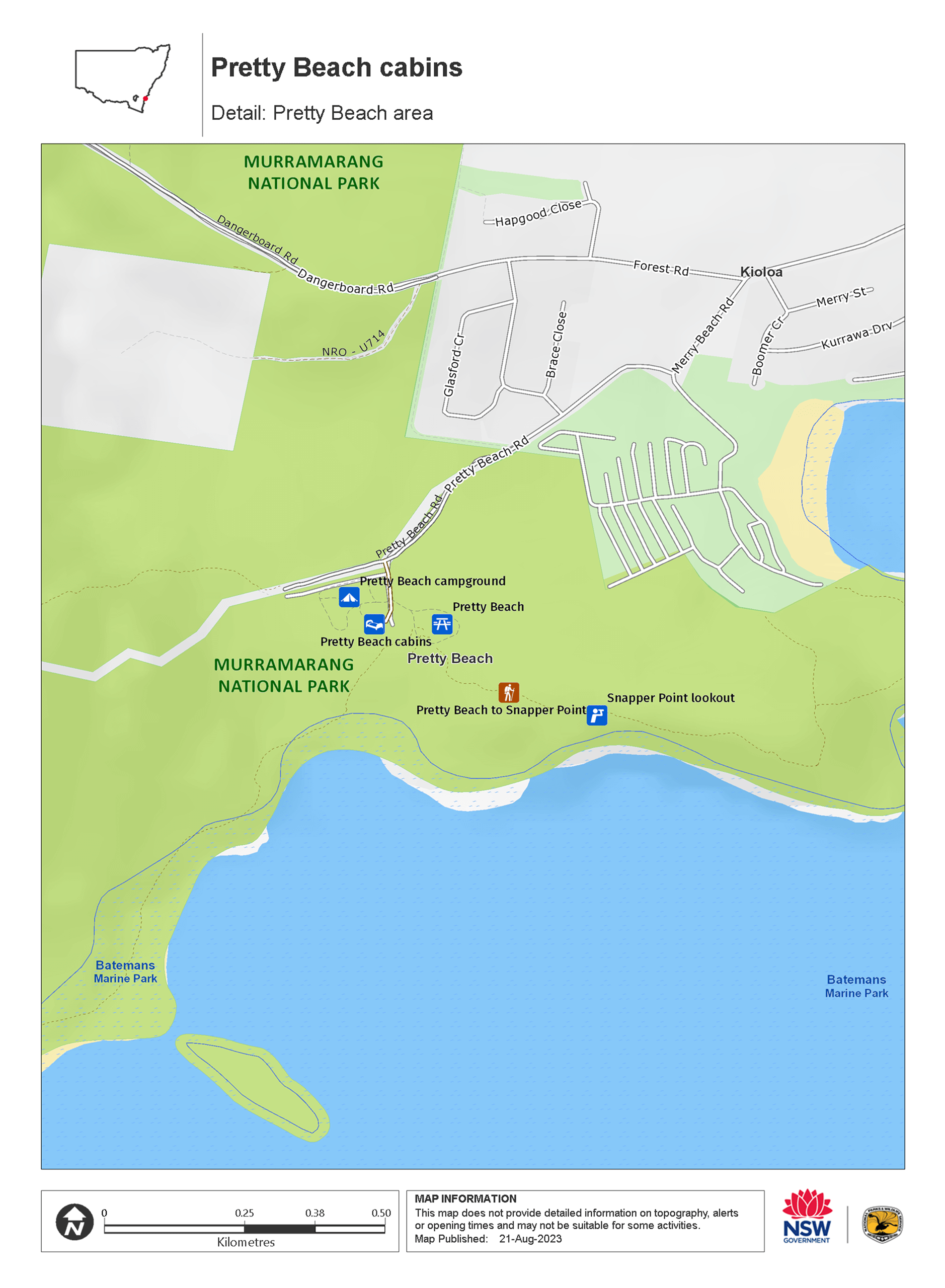
Map legend

Local alerts
For the latest updates on fires, closures and other alerts in this area, see https://www.nationalparks.nsw.gov.au/camping-and-accommodation/accommodation/pretty-beach-cabins/local-alerts
Bookings
- National Parks Contact Centre
- 7am to 7pm daily
- 1300 072 757 (13000 PARKS) for the cost of a local call within Australia excluding mobiles
- parks.info@environment.nsw.gov.au
Operated by
- Pretty Beach campground
- Open daily, 8.30am to 4pm variable. Closed Christmas Day.
- 02 4457 2019
- pretty.beach@environment.nsw.gov.au
- 1 Pretty Beach Road, Pretty Beach NSW 2539
Park info
- in Murramarang National Park in the South Coast region
Murramarang National Park is always open but may have to close at times due to poor weather or fire danger.
-
Park entry fees:
$8 per vehicle per day. The park has pay machines - cash and credit cards accepted. Card only at Pretty Beach.
Buy annual pass
Visitor info
All the practical information you need to know about Pretty Beach cabins.
Getting there and parking
Get driving directions
Pretty Beach campground is located in Murramarang National Park.
To get there from Sydney:
- From the Princes Highway, take the Bawley Point Road exit at Termeil, then follow Bawley Point Road for 5km.
- Continue onto Shearwater Crescent, then turn right onto Murramarang Road.
- Take a slight left onto Merry Beach Road, then turn right onto Pretty Beach Road and follow the road to the campground.
To get there from Canberra:
- Travel east along the Kings Highway, then exit onto the Princes Highway.
- From the Princes Highway, take the Bawley Point Road exit at Termeil, then follow Bawley Point Road for 5km.
- Continue onto Shearwater Crescent, then turn right onto Murramarang Road.
- Take a slight left onto Merry Beach Road, then turn right onto Pretty Beach Road and follow the road to the campground.
If you’re travelling from Canberra, Google Maps may direct you to take Bucks Road from The Princes Highway. This road is very rough and not suitable for 2WD vehicles. We suggest you take the Bawley Point Road exit at Termeil instead.
Road quality
- Unsealed roads
Vehicle access
- 2WD vehicles
Weather restrictions
- All weather
Parking
Parking is available at Pretty Beach campground including several designated disabled spots.
Best times to visit
There are lots of great things waiting for you in Murramarang National Park. Here are some of the highlights.
Spring
Spring is a great time to dust off your hiking boots and take to the park's tracks. Try the Pretty Beach to Durras Mountain walk for spectacular views of the coast and ranges.
Summer
There's no better time to head down the coast and catch some sunshine. With crystal clear waters for swimming and snorkelling, a beach camping trip is the ideal way to enjoy the Aussie summer.
Winter
Birdwatching opportunities abound at this time of year, see if you can catch the courting displays of lyrebirds in the park's rainforest areas.
Facilities
- Bedding configuration: 2 bedrooms. 1 queen bed and 1 set of single bunk beds.
- Water is available at the cabins and campground but it’s tank water so you’ll need to boil it before drinking.
- Combined lounge/dining room with seating.
- Bathroom with shower and toilet in all cabins.
- Pillows are provided.
- Additional facilities are available at Pretty Beach campground. You can buy firewood and ice at the campground.
- Please leave the cabin clean and tidy, with all kitchen items washed up and put away. Additional fees may be charged for any unreasonable cleaning required, or for missing or broken items.
- There's limited mobile phone service at Pretty Beach.
Toilets
- Flush toilets
Drinking water
The cabins use rainwater tanks. Water should be boiled before drinking.
Showers
- Hot showers
Electric power
Solar power.
Kitchen
Plates and cutlery
Pots and pans
TV
TV, DVD and CD player in each cabin.
Rubbish bin
Maps and downloads
Accessibility
The cabins are not wheelchair accessible
Permitted
Camp fires and solid fuel burners
Fires are permitted in approved containers only. No fires are permitted on the ground or beach.
Prohibited
Gathering firewood
Please bring your own firewood or buy firewood at the campground office.
Generators
Pets
Pets and domestic animals (other than certified assistance animals) are not permitted. Find out which regional parks allow dog walking and see the pets in parks policy for more information.
Smoking
NSW national parks are no smoking areas.
Learn more
Pretty Beach cabins is in Murramarang National Park. Here are just some of the reasons why this park is special:
Bird watching
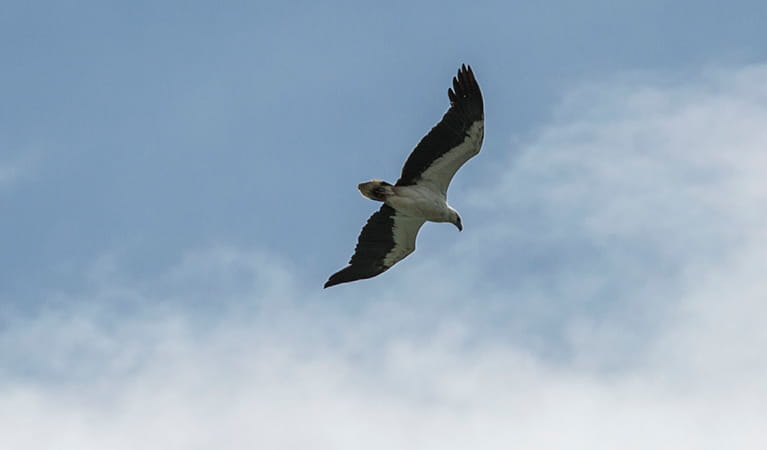
Birdwatchers are in for a treat; the park boasts more than 90 species of birdlife including three owl species, peregrine falcons, sea eagles, gannets, shearwaters, white-faced storm petrels, sooty oystercatchers, eastern yellow robins, satin bowerbirds, the rufous fantail and even a penguin colony. Look for the sea eagles and peregrine falcons soaring above the park’s cliffs and headlands and the rufous fantails and eastern yellow robins in rainforest gullies around Durras Mountain. You’re most likely to see sooty oystercatchers wading around the edges of lake areas.
Native animals
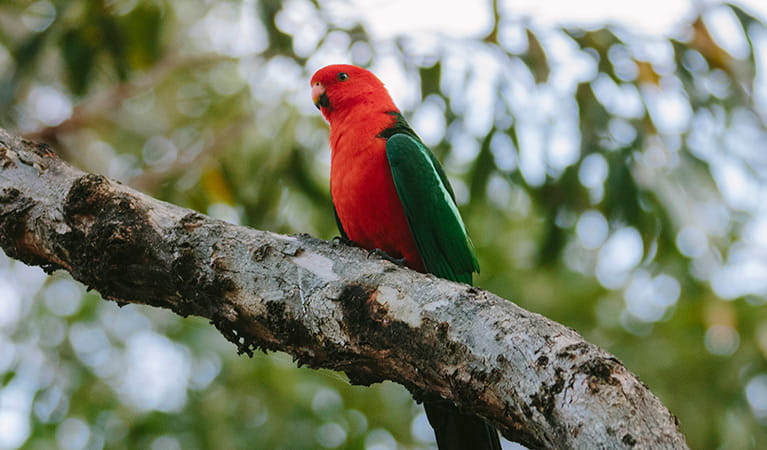
There’s an abundance of wildlife living in Murramarang National Park, but by far one of the highlights is seeing eastern grey kangaroos that spend their days dozing near the beaches and by campgrounds until dusk when they gather to feed. In the moist forests of the park you might see lyrebirds fossicking in leaf litter. Look for the stately, strutting wonga pigeon with its pastel blue-grey back feathers and black dotted stomach. If you don’t see it, you may well hear its repetitive, deep ‘whoop, whoop’ call that carries through the forest.
- Burrawang walking track Burrawang walking track, across Depot Beach Headland, features scenic coastal views, forests and birdwatching in Murramarang National Park, near Batemans Bay.
- Richmond Beach Richmond Beach is one of Murramarang’s hidden treasures. Just 50m from the carpark on an easy walking track you can enjoy picnicking, swimming, snorkelling, fishing and paddling.
Native vegetation
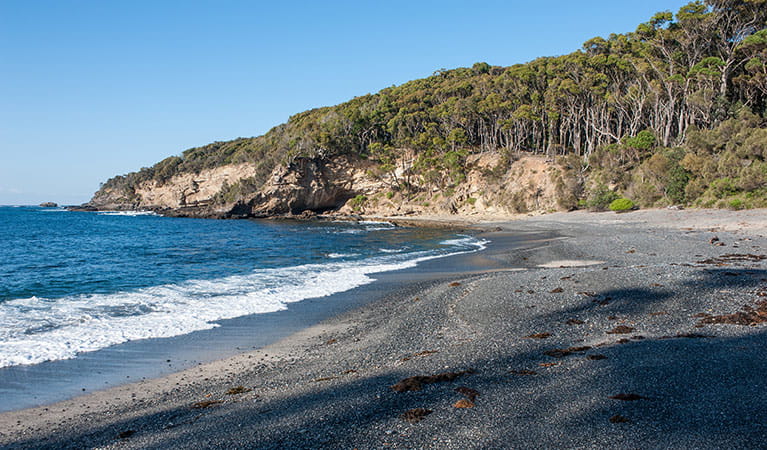
One of the really special things in Murramarang is the forest of majestic spotted gums; it’s one of the biggest continuous stands in NSW. With an understorey of burrawang palms, the forest stretches right down to the ocean and is truly a sight to see. You’ll easily recognise the spotted gums – they have a smooth, dimpled bark which is shed in summer to produce a mottled cream and grey ‘spotted’ appearance.
- Dark Beach walking track Dark Beach walking track leads to a secluded beach with unique rock formations in Murramarang National Park. Ideal for fishing, swimming and snorkelling.
- Depot Beach Rainforest walk Depot Beach marks the start and end of this easy walk through lush littoral rainforest. Go for a swim, surf, snorkel or paddle in the clear waters when you return.
- Rock Platform walk - Depot Beach Rock Platform walk near Depot Beach is a short walk to fascinating rockpools offering excellent birdwatching and scenic ocean views of the South Coast, just north of Batemans Bay.
Rich Aboriginal cultural heritage
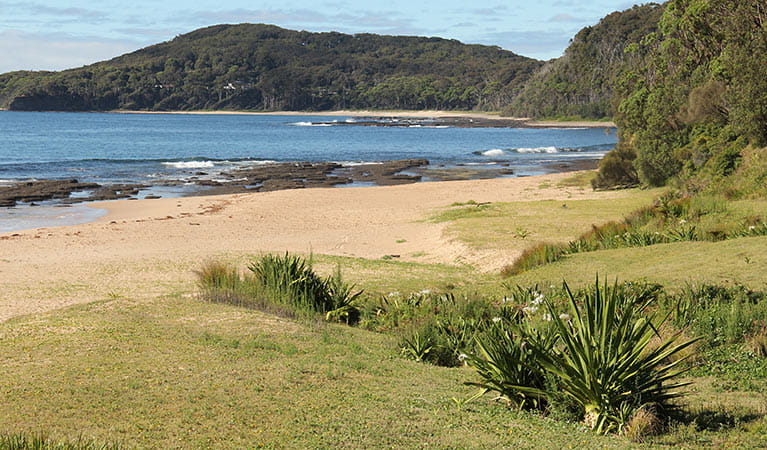
Aboriginal people have a long connection with the Country of Murramarang National Park, and this continues to the present day. The south coast headlands have long been a focus for economic life, giving easy access to the food resources of both the sea and the land, and plants within the park provided medicines and shelter. There is much evidence of the past today, including shell middens, tool manufacturing sites and indications of a specialised industry producing bone points and fishing hooks. Take a walk around Murramarang Aboriginal Area, near Bawley Point - there's a complex of middens that are of great cultural value.
- Then and now: Aboriginal culture Aboriginal culture then and now is a Stage 2 (Years 3-4) school excursion in Murramarang National Park, focusing on Geography and History. Through story and creative expression, the life and culture of the local people are shared.
- Then and now: Aboriginal culture Then and now: Aboriginal culture is a Stage 4 (Years 7-8) school excursion in Murramarang National Park, focused on History. Through story and creative expression, the life and culture of the local people are shared.
- Then and now: Aboriginal culture This excursion experience has been updated and is now being delivered in line with the new NSW Department of Education Curriculum. We will be revising this excursion's name and information online soon. Contact your local national parks office for more information about the updated excursion.
- Wasp Head walk This short walk leads to a spectacular view of Wasp Island and passes through historic Aboriginal sites of the area.
Plants and animals protected in this park
Animals
-
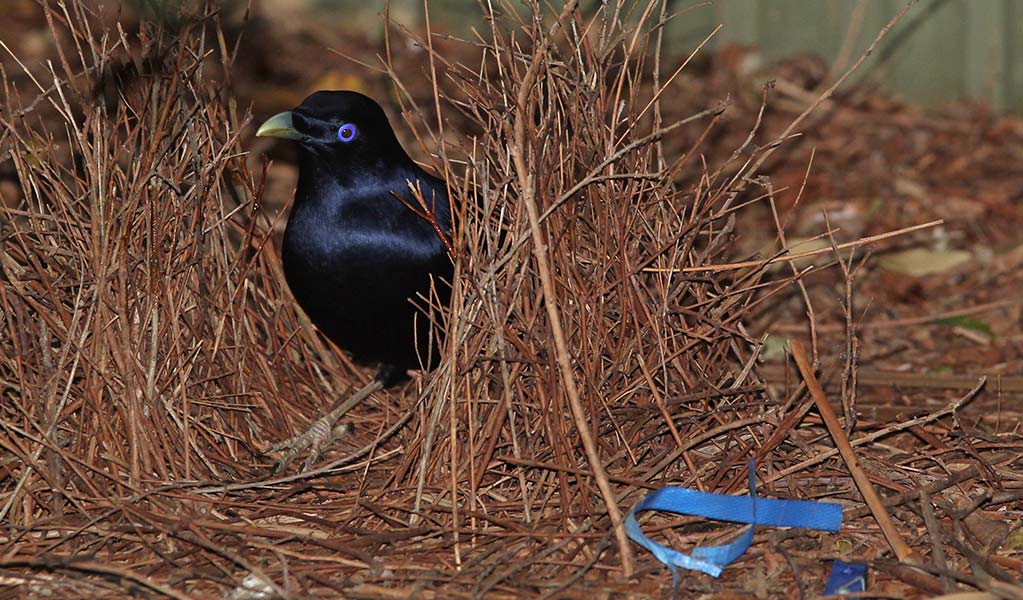
Satin bowerbird (Ptilonorhynchus violaceus)
With vibrant blue-violet eyes and curious antics, the satin bowerbird is a favourite for bird watching and easy to spot as it forages for food in open forest. Relatively common across eastern Australia, in NSW they’re found in coastal rainforests and adjacent woodlands and mountain ranges.
Plants
-
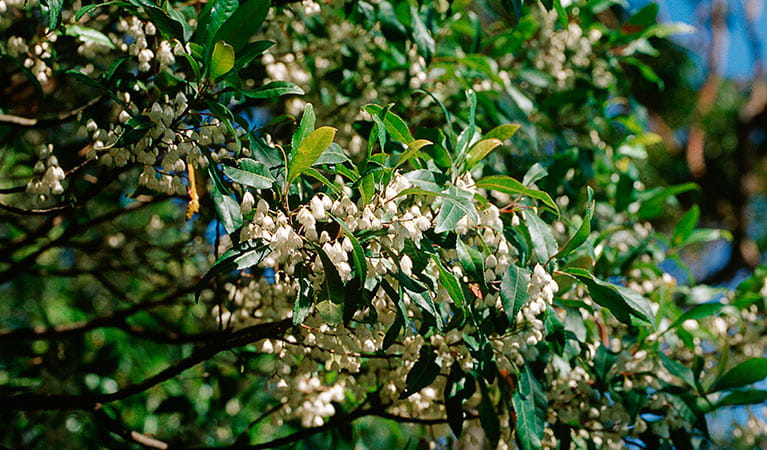
Blueberry ash (Elaeocarpus reticulatus)
The blueberry ash is a rainforest shrub which produces blue olive-shaped berries and spectacular bell-shaped flowers, which often appear on the plant together. It is a tall slender shrub or small tree found in rainforest, tall eucalypt forest and coastal bushland in eastern NSW, south-east Queensland and Victoria.
-
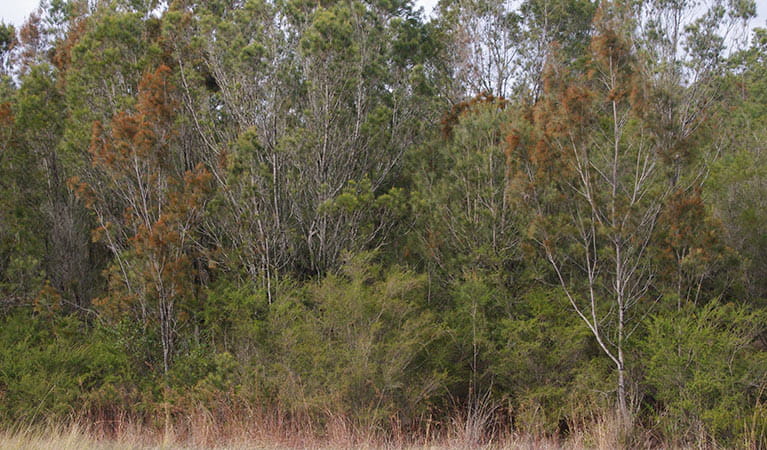
Black sheoak (Allocasuarina littoralis)
The black sheoak is one of a number of casuarina species found across the east coast of Australia and nearby tablelands. Growing to a height of 5-15m, these hardy Australian native plants can survive in poor or sandy soils. The barrel-shaped cone of the black sheoak grows to 10-30mm long.
-
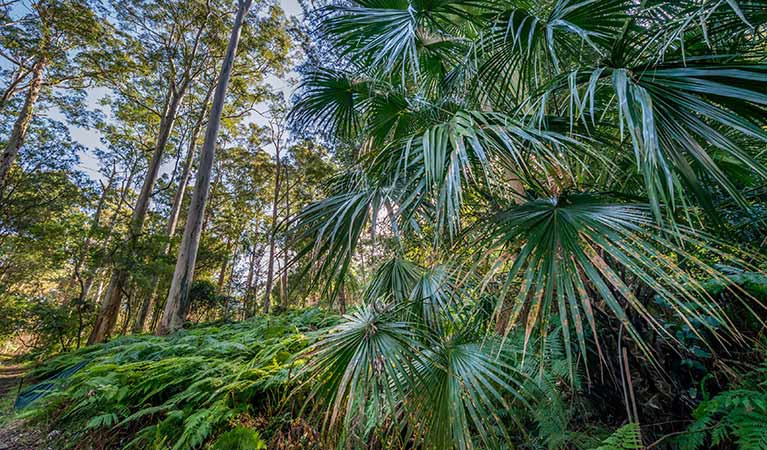
Cabbage palm (Livistona australis)
With glossy green leaves spanning 3-4m in length and a trunk reaching a height of up to 30m, the cabbage tree palm, or fan palm, is one of the tallest Australian native plants. Thriving in rainforest margins along the east coast of NSW, in summer this giant palm produces striking spikes of cream flowers which resemble cabbages.
-
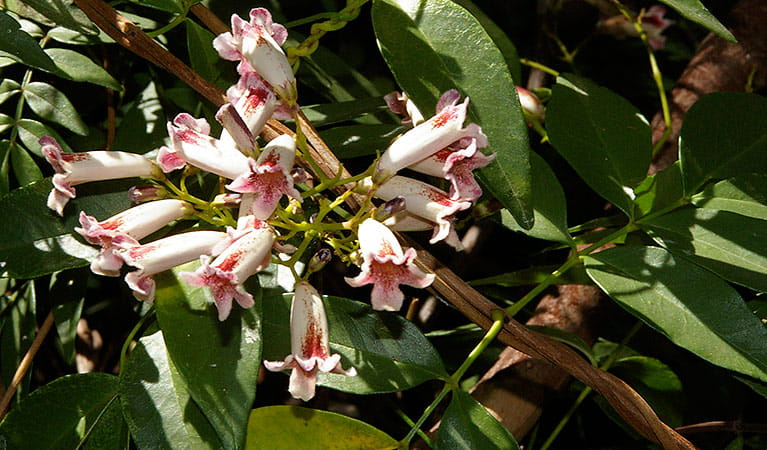
Wonga wonga vine (Pandorea pandorana)
The wonga wonga vine is a widespread vigorous climber usually found along eastern Australia. A variation of the plant occurs in the central desert, where it resembles a sprawling shrub. One of the more common Australian native plants, the wonga wonga vine produces bell-shaped white or yellow flowers in the spring, followed by a large oblong-shaped seed pod.
Environments in this park
Education resources (1)
School excursions (3)
Bookings
- National Parks Contact Centre
- 7am to 7pm daily
- 1300 072 757 (13000 PARKS) for the cost of a local call within Australia excluding mobiles
- parks.info@environment.nsw.gov.au
Operated by
- Pretty Beach campground
- Open daily, 8.30am to 4pm variable. Closed Christmas Day.
- 02 4457 2019
- pretty.beach@environment.nsw.gov.au
- 1 Pretty Beach Road, Pretty Beach NSW 2539
Park info
- in Murramarang National Park in the South Coast region
Murramarang National Park is always open but may have to close at times due to poor weather or fire danger.
-
Park entry fees:
$8 per vehicle per day. The park has pay machines - cash and credit cards accepted. Card only at Pretty Beach.
Buy annual pass
What's nearby:
Things to do (29)
- Aboriginal culture (2)
- Beach (1)
- Birdwatching and wildlife encounters (18)
- Canoeing/paddling (4)
- Fishing (8)
- Historic heritage (1)
- Picnics and barbecues (6)
- Sightseeing (14)
- Snorkelling and scuba (7)
- Surfing (3)
- Swimming (13)
- Walking (19)
- Waterfalls (1)

